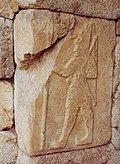
Back Hetiete Afrikaans Hethiter ALS حيثيون Arabic حيثيين ARZ Hitites AST Hetlər Azerbaijani هیتیتلر AZB Хеттар Bashkir Hetitā BAT-SMG Хеты Byelorussian




The Hittites were an ancient people from Anatolia who spoke an Indo-European language. They wrote with cuneiform script. They established a kingdom centered at Hattusha in north-central Anatolia from the 18th century BC.
At its peak, the Hittite Empire covered most of modern Turkey and Syria. This was under the reigns of Suppiluliuma I (~1350–1322) and Mursili II (~1321–1295 BC). They had up-and-down relationships with the New Kingdom of Egypt to the south and the Assyrian Empire in Mesopotamia. They were a party to the first known peace treaty, made with Ramesses II of Egypt by Hattusili III in 1258 BC.
After 1180 BC, the empire disintegrated into several independent "Neo-Hittite" city-states, some surviving until as late as the 8th century BC.
- ↑ Data from Open Genomes and Damgaard et al. 2018; Map colouring: Casippo Open Genomes
© MMXXIII Rich X Search. We shall prevail. All rights reserved. Rich X Search